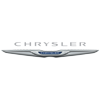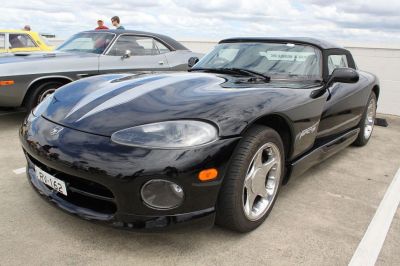 1992 Chrysler Viper RT/10 Dimensions, Size & Specs
1992 Chrysler Viper RT/10 Dimensions, Size & SpecsMeasurements of the 1992 Chrysler Viper RT/10, engineered for optimal performance and comfort
| Dimensions | |
|---|---|
| Length: | 4448 mm175.1 in14.6 ft |
| Width: | 1924 mm75.7 in6.3 ft |
| Height: | 1117 mm44.0 in3.7 ft |
| Trunk Capacity: | 334 liter11.8 cu ft |
| Weight Specifications | |
| Curb Weight: | 1595 kg3516 lbs |
| Maximal permitted Weight: | 1805 kg3979 lbs |
| Tire Specifications | |
| Tire Sizes: |
|
The Chrysler Viper RT/10, produced between 1992 and 1997, is an iconic American sports cabriolet renowned for its aggressive styling and raw performance. This first-generation Viper boasts a length of 4,448 millimeters (175.1 inches), a width of 1,924 millimeters (75.7 inches), and a low height of just 1,117 millimeters (44.0 inches), giving it a distinctive wide and low stance that emphasizes its sporty character. With a curb weight of 1,595 kilograms (3,517 pounds), the Viper RT/10 blends lightweight construction to enhance agility, while its maximum weight capacity reaches up to 1,805 kilograms (3,979 pounds). The car’s luggage capacity measures a practical 334 liters (11.8 cubic feet), an impressive figure for a sports convertible, offering decent storage space for weekend outings or track days. The Viper RT/10 rides on performance-oriented tires sized 275/40 R17 at the front and 335/35 R17 at the rear, reflecting its focus on grip and high-speed stability. Overall, the Chrysler Viper RT/10 stands out as a bold sports car of the 1990s, combining muscular dimensions with lightweight engineering and ample cabin openness due to its cabriolet design, making it a cult favorite among enthusiasts and collectors worldwide.
Discover the standout features that make the 1992 Chrysler Viper RT/10 a leader in its class
Have a question? Please check our knowledgebase first.
The Chrysler Viper RT/10 produced between 1992 and 1997 has a length of 4448 mm (175.2 inches), a width of 1924 mm (75.7 inches), and a height of 1117 mm (44.0 inches). These dimensions highlight its low, wide proportions indicative of its high-performance sports car design, emphasizing aerodynamics and road presence. The relatively low height contributes to a sporty and aggressive stance, while the width provides good stability at high speeds.
The curb weight of the Chrysler Viper RT/10 during its production from 1992 to 1997 is approximately 1595 kilograms (3516 pounds). The maximum weight, taking into consideration passengers, cargo, and fuel, is rated at around 1805 kilograms (3979 pounds). This weight reflects the balance Chrysler aimed for between performance and structural integrity, making the Viper a powerful yet relatively lightweight sports car for its class during the era.
Despite being primarily a high-performance sports car, the Chrysler Viper RT/10 features a luggage capacity of 334 liters (approximately 11.8 cubic feet). This capacity is fairly generous for a two-seater sports convertible, allowing owners to carry a modest amount of luggage, suitable for short trips or weekend getaways. The storage space is designed to balance the car's performance focus with some practical usability.
The Chrysler Viper RT/10's dimensions—4448 mm (175.2 inches) in length, 1924 mm (75.7 inches) in width, and 1117 mm (44.0 inches) in height—mean it generally fits comfortably within a standard residential garage. Most standard single-car garages have widths between 2400 to 3000 mm (94 to 118 inches) and lengths of approximately 5400 to 6000 mm (212 to 236 inches). Therefore, the Viper’s width and length fit well within these dimensions. However, drivers should always consider additional clearance for opening doors and maneuvering within the garage.
The Chrysler Viper RT/10 is equipped with performance-oriented tires sized 275/40 R17 at the front and 335/35 R17 at the rear. The front tires measure 275 mm in width with a 40% aspect ratio, while the rear tires are significantly wider at 335 mm with a 35% aspect ratio. These wide rear tires provide exceptional traction needed to handle the Viper's powerful engine output, especially during acceleration and cornering. The staggered setup improves overall grip, stability, and responsiveness, which are essential for a sports car with aggressive handling dynamics.
The Chrysler Viper RT/10, introduced in 1992, was the first production generation of the Viper line, so it technically has no direct predecessor in production form. However, it drew inspiration from the 1989 Dodge Viper Concept. The production RT/10 retained the concept’s ultra-low, wide, and long dimensions but was engineered for road legality and safety. It set the foundation for subsequent Viper models, with its size emphasizing aerodynamic performance and aggressive styling. Later generations grew in size and weight but maintained the fundamental low-slung sports car profile.
When compared to other iconic 1990s sports cars like the Chevrolet Corvette (C4) or the Porsche 911 (993), the Chrysler Viper RT/10 is generally larger in width and length but lower in height. For example, the 1992 Chevrolet Corvette measured about 4485 mm (176.6 inches) in length and 1822 mm (71.7 inches) in width, whereas the Viper is wider at 1924 mm (75.7 inches). This broader stance offers superior stability, especially during high-speed cornering. The low height of 1117 mm (44.0 inches) also accentuates its aerodynamic advantage and aggressive look in comparison.
The Chrysler Viper RT/10 is a strict two-seater with a focus on driver engagement and performance rather than spaciousness. Its low height and wide stance optimize aerodynamics and handling but limit interior headroom and cargo space. The seating compartment is snug, with an emphasis on keeping the driver and passenger firmly in place during spirited driving. Although the luggage capacity is a respectable 334 liters (11.8 cubic feet), the interior space itself is oriented toward functionality and performance rather than comfort or passenger space, typical for high-performance roadsters.
The dimension design of the Chrysler Viper RT/10 played a key role in its iconic status. Its low height of 1117 mm (44.0 inches), wide stance of 1924 mm (75.7 inches), and length of 4448 mm (175.2 inches) give it an imposing yet sleek profile that stands out among American sports cars of the early 1990s. The combination of aggressive proportions helped underscore its raw power and track capability, making it instantly recognizable. The Viper became a symbol of American engineering bravado through its distinctive size and muscular styling.
The Viper RT/10’s size provides several benefits such as excellent road grip and handling due to its wide track and low center of gravity. Its length and width contribute to a noticeable presence on the road and stability at high speeds. However, the relatively large width for a sports car (1924 mm or 75.7 inches) can pose challenges in tight urban environments, narrow parking spaces, and heavy traffic. The low height (1117 mm / 44.0 in) can also limit visibility and ease of ingress/egress. Thus, while the Viper excels in performance driving, it demands consideration for daily practicality.
Discover similar sized cars.

| Production: | 1995-2002 |
|---|---|
| Model Year: | 1996 |
| Length: | 4448-4475 mm175.1-176.2 in |
| Width: | 1924 mm75.7 in |
| Height: | 1118 mm44.0 in |

| Model Year: | 1992 |
|---|---|
| Length: | 4448 mm175.1 in |
| Width: | 1924 mm75.7 in |
| Height: | 1117 mm44.0 in |
